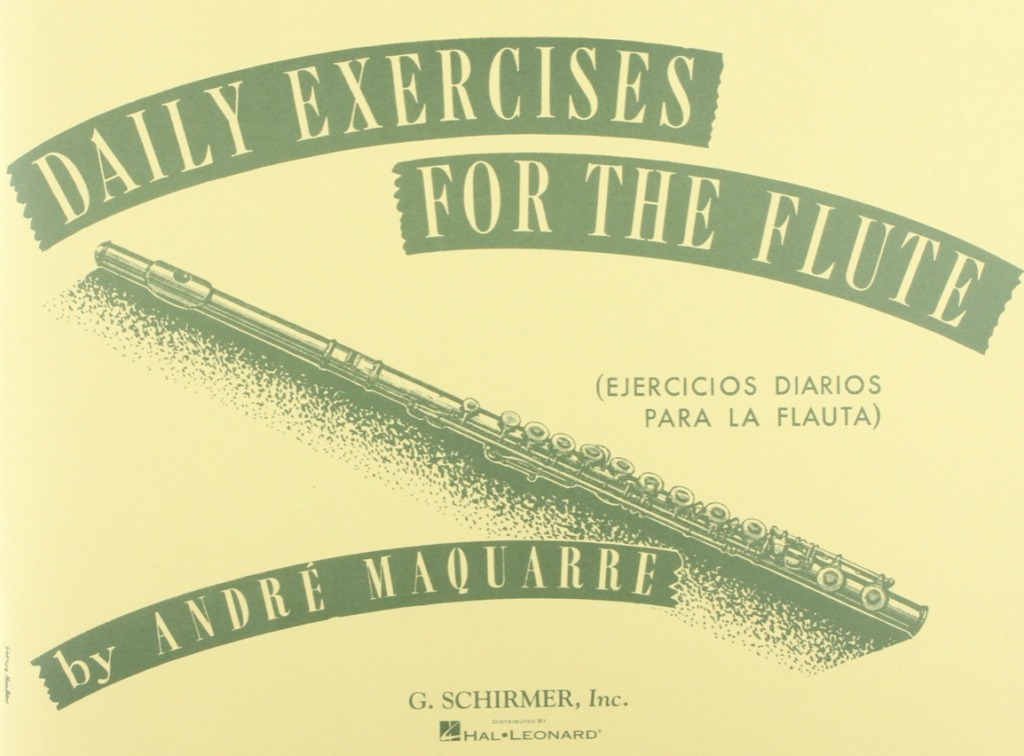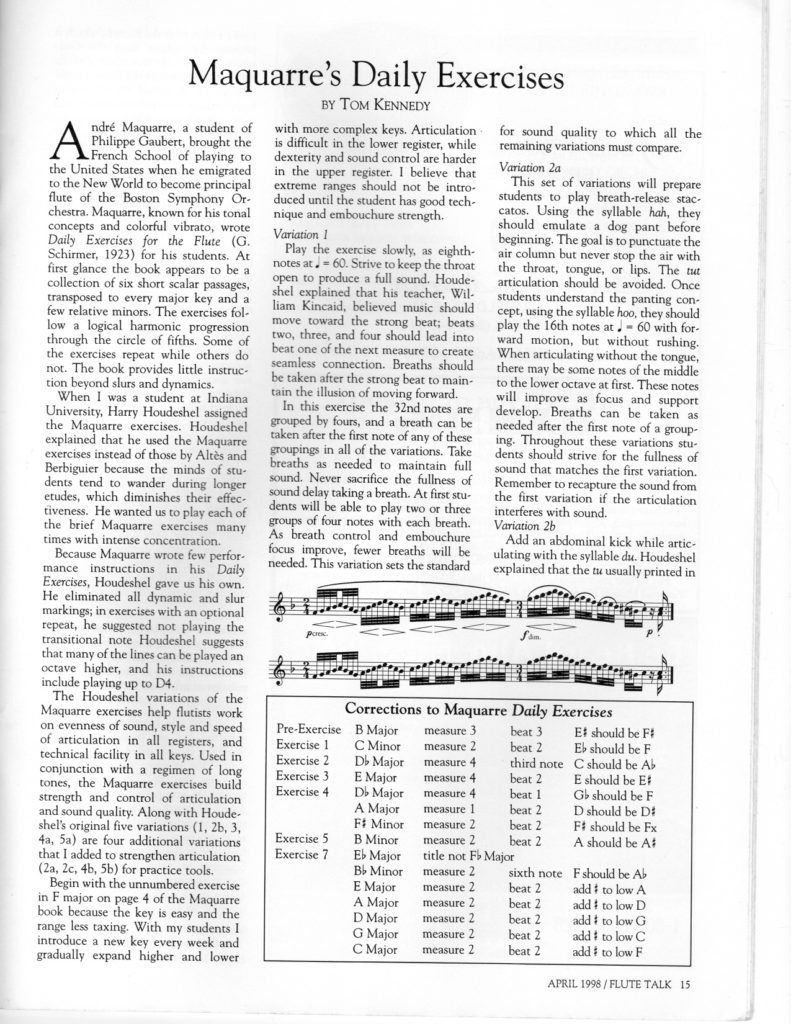Maquarre Daily Exercises: Scales and Articulation
The Daily Exercises are the perfect exercises for building technique in the intermediate-advanced student.
As a teacher, I use Daily Exercises for the Flute by Andre Maquarre with high school students. It is an excellent bridge between the Rubank Advanced Method Vol. 2 and some of the harder repertoire pieces like the French Conservatory pieces.
Daily Exercises for the Flute by André Maquarre is available from Amazon.com for $7.99 at the time of this writing (May 2020). When I first purchased this book in 1991, it was quite expensive because the French edition was the only one available. Fortunately, the price has dropped and it is readily available in the US from G. Schirmer.

Although this is advertised as the “Spanish edition,” instructions are also given in English.
The following sequence was taught to me by my teacher Dr. Tom Kennedy. When I was in high school, I studied with Dr. Kennedy at Wittenberg University. These Daily Exercises helped me tremendously.
Regular practice of one line of the Daily Exercises will strengthen the following:
- Solid, focused tone
- Breath control
- Phrasing
- Vibrato
- Light, bouncy staccato
- Legato, connected notes
- Technical facility with major and minor scales
- Smooth single tonguing
- Rapid, even double tonguing
- Critical listening skills
Spending just five minutes per day on one scale has all of these benefits and more!
The History
Andre Maquarre wrote the Daily Exercises in 1923. Maquarre was French and a student of Philippe Gaubert. When he emigrated to the US to play with the Boston Symphony Orchestra, Maquarre brought with him the ideas from the French Flute School.
Maquarre’s Daily Exercises were taught to me by my flute teacher, Dr. Tom Kennedy. He expanded on the series originally taught to him by Harry Houdeshel at Indiana University. The phrasing ideas come directly from Houdeshel’s teacher, William Kincaid.
Groundwork
Work on only one scale per day. Each line will be played a total of nine times, but you can rest between each variation. Ignore all of the dynamic markings. Do not play the final note of the line. The double notes are “transition” notes if repeating or playing the entire scale study top to bottom.
With my students, I like to assign one scale each week, beginning with easier keys and progressing to ones with more sharps and flats and in the higher and lower octaves. I alternate major and minor keys each week.
Only breathe after the first note in each grouping of four. William Kincaid taught his students this phrasing trick. For more on this style of phrasing, refer to the book Kincaidiana by John Krell. On the slow exercises, breaths may need to be taken after only 5 or 9 notes. Do not breathe between notes 4 and 5, 8 and 9, and so forth.
The Maquarre Daily Exercises contain a few mistakes. The table below shows the corrections:

The Daily Exercises Series
Choose one exercise from the first series on pp. 4-8. Start with a scale in the middle of the range that has a simple key signature. The key of F Major is a good first exercise.
Variation 1: Long Tones
Play the scale exercise slowly and with great care, no faster than eighth notes at mm=60. Be critical of the sound. Ask yourself, “Is this the best sound I can make today?” If the answer is no, restart and refocus. Breaths will need to be taken frequently to maintain the full sound. Set the standard for tone quailty for all of the other exercises. Alternate days of using vibrato and no vibrato on this variation.
Variation 2: Breath-Release Staccato
2a. Use the unarticulated “ha” to begin each note. Do not use the tongue to start the note, only the air. To get the feel of this articulation, pant like a dog. Notice that the belly moves quite a bit and the air is forceful. Each note will receive a puff of air. Try to control the sound, but in the beginning the notes will probably crack quite a bit. Begin slowly but as the muscles get stronger, you can increase the speed. Try to maintain the tone quality as in variation 1.
2b. Same as 2a, but now articulate the note using the tongue as if saying the word “du” or “da.” Remember that the sound begins with the air column, not the tongue. The articulation should be clean and the notes as strong and clear as in 2a.
2c. Use the articulation “gu” to begin the note. Continue working toward the focused breath-release staccato but use the gutteral tonguing. Try to make this sound the same as 2b. Although it will be rare to use this articulation in music, strengthening this tongue placement will make double tonguing easier.
Variation 3: Fast Technique
Slur the entire line and play as fast as possible. Maintain a wonderful sound and connect the notes with good phrasing. Challenge yourself to play the whole line in one breath.
Variation 4: Single Tonguing
4a. Use the “du” articulation. Play as fast as possible, preferably in one breath as in variation 3. Do not sacrifice tone quality. Work toward a quick, smooth articulation that is even. Think of one column of air, like a “hot knife going through butter” as TK would say. This variation requires a lot of air. Think of a flag blowing in the wind or a stone skipping across water.
4b. Use the “gu” articulation. Keep the same speed and tone quality as 4a. You will probably notice that the “gu” articulation feels heavier and does not have as much stamina as the forward articulation. This variation strengthens the “gu” articulation and brings attention to its weaknesses.
Variation 5: Double Tonguing
5a. At a fast tempo and with as few breaths as possible, maintain the best sound quality while double tonguing with the syllables “du-gu.” The air is always more important than the tongue. Think about a light quick tap of the tongue on the top of the mouth, a gentle rocking motion. Listen carefully to see if the notes are even. There is a danger that the notes will develop a swing when the “gu” articulation is slower than the “du.”
5b. Also double tonguing but the articulation is the reverse of 5a: “gu-du.” Now the “gu” articulation is on the strong beats. Listen carefully because the tendency is to flip the articulation about halfway through the exercise when the tongue gets tired. This variation helps to make the “gu” articulation strong and even. Flutists sometimes have to start articulated runs with “gu,” like when there are three-note pick-ups in a fast tempo.
Additional Reading
Tom Kennedy wrote a Flute Talk article about the Maquarre Daily Exercises in the April 1998 issue.

I feel incredibly fortunate to have worked with Tom Kennedy while in high school. His influence on my flute teaching is strong. When I think of the lineage of flute teachers, a family tree branches out. Andre Maquarre was inspired by his French teachers. He, in turn, spawned a new generation of American players and left a lasting legacy of the Daily Exercices. I went on to study with other teachers who had legacies of teachers and teachings themselves. And I carry all of this forward to my students.
1 comment